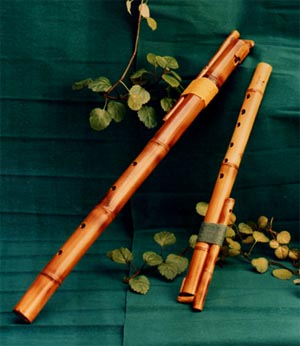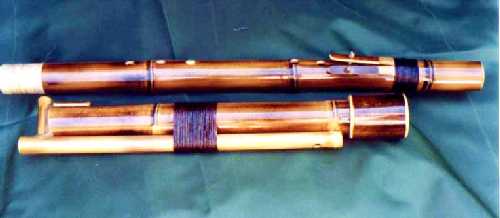Traditional
moseños used to be made of local bamboos from South
America, as Aulonemia queko, tuned in ritual scales.
At their local Aymara area, moseños are made in various sizes,
depending the age of the player. It is traditionally played
in high overtones.
Once
spreaded in a broader Latinamerican area,the main feature
of the moseño is the lateral tube, which acts as a
long wind channel that makes it easy to play. It is side-blown,
but the sound is produced by a fipple instead of a transverse
embouchure. Also, the way as it is played in folk and other
music groups has changed, becoming a sort of bass flute.
Nowadays,
we build this instrument with very selected pieces of
Phyllostachys aurea, an extraordinary bamboo from the
Delta, Argentina.
We take care of the storage and selection of each culm to
make our flutes.
|
Moseño
in G3 (86 cm) and in C4 (64 cm) 
Note:
We heve changed the word moxeño for "moseño",
considered more correct. It is still used as sinonimus in
Argentina. Anyway, you can find this instrument called as
"mocenio" or "mosenio" in other places
|
PITCHES
AND LENGTHS |
Moseños
are played as bass flutes, with 2 and a half octaves .
Although they can be tuned in high pitches,
we recommend to play this register on quenas or pinkuyos |
Re4/D4=57
cm
Do4/C4=64 cm
|
D4
moseño tuning is the same as the Renaissance flute, and
the quenacho or bass quena.
The moseño in C4 is tuned in the same pitch of the orchestral
flute |
Sound
of C4 moseño
click here
|
Sol3/G3=86cm
Fa3/F3=94 cm |
G3
moseños are the most frequently used.
They are tuned an octave bellow the normal quena.
F3 is tuned as the bass recorder |
|
Re3/D3=115cm |
D3
are an octave bellow the quenacho,
producing a profound and deep sound.
C3 moseños are longer and lower, then they required a
key |
|
VARIANTS |
Demountable
and keyed moseños |
Due
to their great size, moseños might be demountable,
in the same fashion as a Bass recorder.
To make the chromatic scale easier, we have developed a special
fingering (see the picture) . It also has two keys at the
foot end
|
FINGERING |
|
Equal
to the traditional quena, our
moseños in D4 and C4 have 6 holes on the front and
one on the back (6-1 system), then obtaining a whole octave
by direct blowing. Overblowing you can get the whole second
octave and some notes of the third.
For bass moseños we have designed another fingering
system: using the index and ring finger and the thumbs (2-1-2-1
system). This method allows almost everybody to reach the
longer tonehole distances of long moseños.
Sharps and flats can be played either by cross fingering (as
in the recorder) or by half-holing (as in the quena)
|
a
similar instrument is the Slovakian Fujara. Traditionally made on wood,
I have made a couple of them in bamboo.
Here
is a video, sorry in Spanish, but can hear it clearly
|


